Buddhist Fables
- The Story of Ruru Deer
- The Story of Two Swans
- The Hare on The Moon
- The Story of Chaddanta Elephant
- The Story of Great Monkey
- The Story of The Two Deer
- The Story of a Buffalo
- Silava Elephant
- The Wise Monkey
- The Story of the Golden Swan
- The Story of The Great Ape
- The Mighty Fish
- Story of the Monkey King
- Lion and Jackal
- Somdatta
- The Story of the Crows
- The Monkey Brothers
- The Story of Nigrodha Deer
- Kalbahu
- Nandivisala
- Coronation of Owl
- The Feast of the Dead
- The Heart of the Monkey
- The Story of a Rooster
- The Story of a Tigeress
- The Pigeon and The Crow
- The Story of Romaka Pigeon
- The Story of Khardiya Deer
- The Thankless Monkey
- Can A Fool Ever Act Good!
- The Story of a Tortoise
- Jackal –The Arbitrator
- The Story of a Snake Charmer
- The Leather Garment
- The Giant Crab
- Mahilaimukha Elephant
- The Story of Vinilaka
Buddhist Classics
- The Sacrifice of Vessantara
- The Wisdom of Vidhura Pandita
- Chullabodhi – The Conqueror of Anger
- The Story of Kushinagar
- The Virtue of Forbearance
- Matanga – The World’s First Crusader of Untouchability
- The Temptation of Isisanga
- The Flight of Sakka
- Mahajanaka’s Renunciation
- The Wine-Jar
- The Sacrifice of Sivi
- The Box of the Monster
- The Lotus Stalk
- Kandari – The Handsome Prince
- Ghat: The Virtuous King
- Supparaka – The Ancient Mariner
- Sankhapala: The Naga King
- Champeyya
- The Baveru Island
- The Great Gambler
- The Story of The Dumb Prince
- The Naive House-Holder
- The Jewelled Serpent
- The Mango-Thief
- The Foot-Print Reader
- The Story of Sutasoma
- The Story of Sudasa
- The Little Bowman
- The Envoy of Belly
- Story of a Drummer
- The King, Who Knew The Language Of Animals
- The Happy Man
- Sama: The Good Son
Life and Legends of Buddha
- Gotama Buddha
- Birth Story of Gotama
- Maha Maya’s Dream
- Sage Asita’s Visit
- The Four Sights
- Story of Renunciation
- The Buddha’s Victory over Mara
- The Personality of the Buddha
- Nalgiri Elephant
- Story of Kumara Kassapa
- Dhamma-Chakka-Pavattana-Katha
- The Buddha’s Teaching of Abhidhamma
- Buddha's Visit to Rahula Mata
- The Savatthi Miracles
- The Flying Buddha
- Story of Parinibbana
- Suddhodana
- Sujata
- Sariputta
- Moggallana
- Story of Mara
- Bimbisara
- Nanda
- Janapada Kalyani Nanda
- The Spiritual Journey of Janapada Kalyani
- Phussa Buddha
- Vipassi Buddha
- Sikhi Buddha
- Vessabhu Buddha
- Kakusandha Buddha
- Konagamana Buddha
- Kassapa Buddha
- Metteya
The Illustrated Jataka & Other Stories of the Buddha by C. B. Varma Introduction | Glossary | Bibliography
086 – Story of Parinibbana
From the Gijjhakuta hill of Rajgir the Buddha started his last journey with a large concourse of monks. Marching through Ambalatthika and Nalanda he reached the village Pataligama (modern Patna; later called Pataliputta). Those days Patali, which was to become the capital of the Mauryans was a village. There the Buddha made a prophecy on the future greatness of the city. From Patali he crossed the river Ganga (British: “Ganges”) and then travelling via Kotigama and Vaishali he broke his journey in the park of Ambapali (Sanskritised: Amrapali). On the following day, he accepted the meals from the courtesan Ambapali by turning down the invitations from the Licchavi nobles. Further, he accepted the park donated by Ambapali for the use of the monks. Then, leaving the monks in Vaishali he proceeded to Beluva to spend the rainy season (Vassavasa). At Beluva he suffered from a terrible illness. Then he told Ananda of his impending death. Later, upon his return to Vaishali after the stay-during-the-rainy-season (Vassavasa) he made the announcement of his death once again before all the monks, who had assembled there.
Further, passing through Hatthigama, Ambagama, Jambugama and Bhoganagara he reached Pava. There, staying in the mango-grove of Chunda, a smith, he ate some food, which made him ill again. (Chunda, the smith is often misidentified with a pork-butcher Chunda Sukarika of Veluvana of Gaya; and the food “sukara-maddava” served to the Buddha is sometimes interpreted as the “pig’s meat”. But such inference is silly because sukara-sali means “wild rice”; and maddava (Skt. Maardava), which is derived from mridu means “sweet”)]. Further, the Pali-English Dictionary (T.W.Rhys Davids & William Stede pp.721; 518-19) interprets maddava as “soft”; and “withered” [or parched]. So, it is quite likely that the food, which the Buddha had consumed, was the parched rice (rice-bhoonja, a popular food-item of north Bihar and Eastern Uttara Pradesh). Furthermore, the Buddha had categorically condemned the profession of the pork-butcher Chunda Sukarika, who had died grunting like a pig for seven days before his death because of his cruel profession; and was tormented in the fire of the hell. [See Dhammapada Atthakatha i.105 ff]. Last but not least, the rules for the acceptance of the food in the Buddhist order were very severe. For example, Sariputta was allowed to take the garlic only for the medical reason).
Controlling the sickness the Buddha then proceeded to Kusinara, now called Kushinagara and rested on the foot of a tree. There he drank the water of Kakkuttha river brought by Ananda. There Pakkusa, a Mallana visited him and offered him a gold-coloured robe. Putting on the robes the Buddha told Ananda that the Buddhas used the gold hue just on the night before Enlightenment; and the night before the death. He then added that he would die in Kusinara.
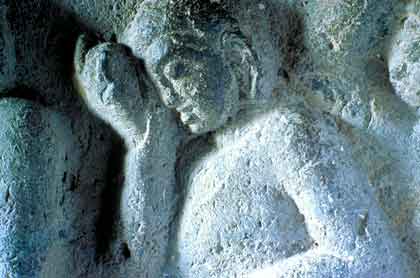 |
 |
| The sick Buddha before his parinibbana | The Buddha and Anand on the bank of the Kakuttha river |
The Buddha then took bath in the Kakuttha river; and then after taking some rest proceeded further and reached Upavattana Sal Grove. There, Ananda prepared a bed for him with the head at north. It is said the the trees blossomed and showered flowers on his body. The divine mandavara flowers and sandal wood powder rained from the sky. The wind played the divine music and sound. The Sal Grove stood stooped fanning him with all the branches of the trees, which was later asked by the celestial beings to move back from obstructing the view of the dying Buddha. It was then that the Buddha gave instructions to Ananda with regard to the funeral rites. Aggrieved Ananda then tried to persuade the Buddha not to die in Kusinara as it was a muddy and wattled village. But the Buddha praised the place because once it was the capital of Mahasudassana.
When the news of the Buddha’s impending death was spread, the Mallas of Kusinara and many others assembled. The Buddha then ordained Subhaddha who Ananda had prevented to come near the ailing Buddha. The Master then asked his monks to put any query or doubt for clarification. But no monk asked any question. He then exhorted the monks:
Decay is inherent in all composite things;
Work out your Deliverance with perseverance.
These were his last words. Then passing through several stages of samadhi (trance) he attained Parinibbana (Great Demise) on the full-moon night of Vishakha month in his eightieth year. The Mallas ignited the pyre. When the pyre was completely burnt, they fenced the spot with spears and observed the commemorative occasion for seven days.
 |
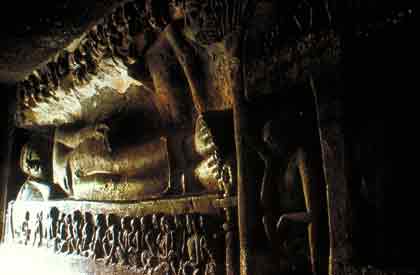 |
| The Buddha’s parinibbana | The Parinibbana Mudra |
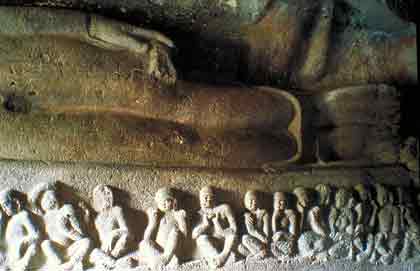 |
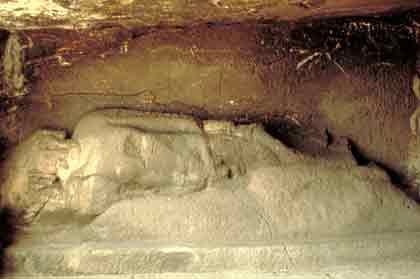 |
After the parinibbana of the Buddha several claimants of the relics appeared; and there was a possibility of the war. Finally, the dispute was resolved; and the relics were divided into eight equal parts among Ajatasattu, the king of Magadha; the Sakiyans of Kapilavatthu; the Koliyas of Ramagama; the Licchavis of Vesali; Bulls of Allakappa; a brahmin of Vellapattha; the delegates of Pava; and the Mallas of Kusinara. Dona, who had played an important role in the distribution of the relics was allowed to keep only the measuring vessel. The Moriyas of Pipphalivana could carry only the ashes owing to their late arrival.
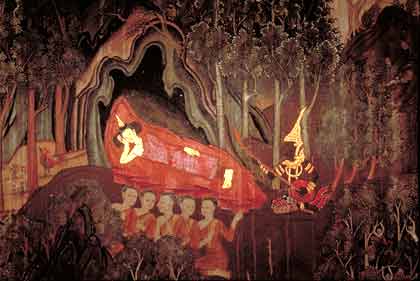 |
| the Thai version |




